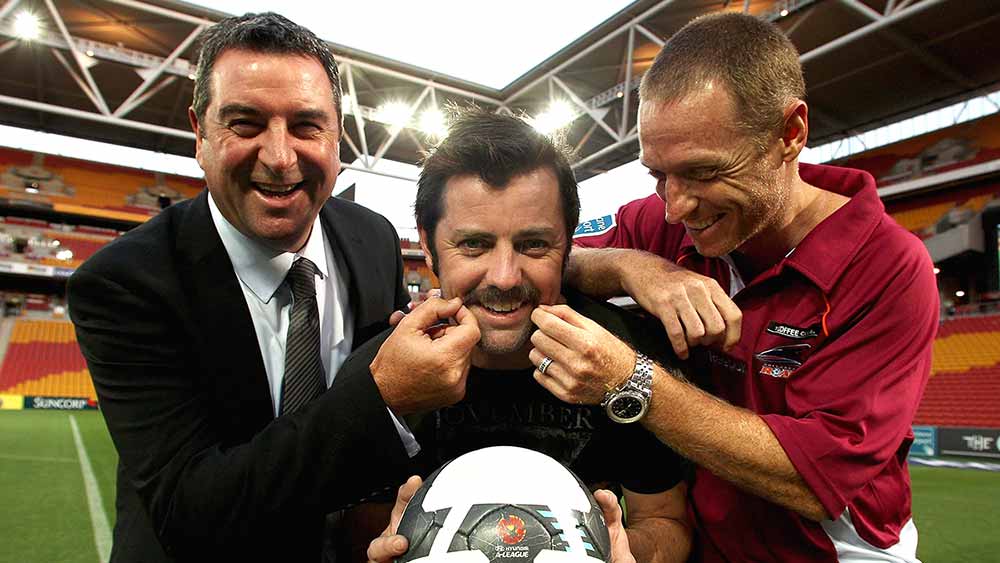The former A-League boss kicking goals for Optiscan

Optiscan boss Archie Fraser (left) with football stars Luke Slattery and Craig Moore back in his A-League days. Pic: Getty
Appointed boss of microscopic imager Optiscan last year, Scotsman Archie Fraser was just the laddie to turn around the company — given his tenure at the normally cellar-dwelling AFL club St Kilda.
Fraser presided over the Saints between 2005 and 2009 and – short of pulling on his boots himself – can take his share of credit for the club’s grand final appearances in 2009 and 2010.
Fraser then switched codes and presided over the Hyundai A-League soccer competition during a growth period.
He also spent a nanosecond at Clive Palmer’s proposed Football Federation that — like Palmer’s Titanic replica — sunk without trace.
Optiscan (ASX:OIL) hired Mr Fraser (by then a management consultant) in May last year, when the company was in a trading halt after a failed capital raising.
“I have learnt from sport that you either play it or watch it,” says Mr Fraser, who opines that running a biotech is a breeze relative to managing a collective of big egos in the sporting world.
Two decades of work in progress
Optiscan was a Circadian (now Opthea) company founded in 1994, working with CSIRO, with now chief scientist Dr Alan Finkel on the board and listed in 1997.
The roll-call of directors includes Vision Systems and Biota’s Dr Jim Fox, George Cameron-Dow and Patrick O’Connor.
The company was recapitalised and was restored to trading in August last year after a $1.4 million rights raising (at 2.5 cents a share).
While $100 million has been poured into Optiscan’s technology over the years, revenues remain microscopic.
One reason is the company has had attention deficit disorder.
“Optiscan’s technology has always been world class but the company was pursuing many things at a time and it missed crucial deadlines,” Mr Fraser says. “We have now put the blinkers on to take the main two products to market.”
Biopsies be gone
Optiscan has developed clinical endo-microscopes that, as the name suggests, allow a person’s innards to be examined without the need for a painful biopsy.
The devices provide surgeons with a real-time view of individual human cells — magnified 1000 times — during a procedure.
The images are conveyed via a single optical fibre placed directly on the tissue. They can see whether a lump is benign or cancer in real time.
In 2002, Optiscan started selling an earlier version of the device for gastrointestinal surgery, via a partnership with Japan’s Pentax (which finally cottoned on that film cameras had about as bright a future as nightmen and blacksmiths).
Pentax was taken over by Hoya and the tie-up fizzled out, but not before 150 systems were sold.
Optiscan then formed a collaboration with German optics house Carl Zeiss Meditec (CZM) and 10 years later the alliance remains intact.
Carl Zeiss has exclusive rights to Optiscan’s neurosurgery, ear, nose, throat and spine applications.
Under the tie-up, Optiscan sells the units to Carl Zeiss, which will then market them under its own name (reportedly Convivo).
Carl Zeiss is expected to gain Conformité Européenne (CE) mark approval shortly, with US Food and Drug Administration consent expected by April 2018.
Probing analysis
Optiscan’s endoscope is a miniature microscope at the end of a single flexible optical wire.
Yes, there are several rival devices on the market but of much lower resolution (gaps in the pixels “like a microwave screen door”, according to the company).
Pilot versions of Convivo are now being showcased at neurosurgical pow-wows in Venice and Boston.
Convivo is expected to be sold alongside CZM’s Kinevo 9000, a newly released surgical microscope with enhanced probing abilities, but without Convivo’s magnification abilities.
One doesn’t have to be Einstein to assume the devices could be merged into one in future.
The Carl Zeiss initial focus is squarely on the neurosurgery market, which requires millimetre-perfect skills.
In the US alone, 700,000 people are diagnosed with brain cancer with 27,000 new cases each year. From this, the company extrapolates a requirement of 4000 to 8000 systems.
In dollar terms, Fraser estimates a $US1 billion ($1.3 billion) global market for neurosurgery alone.
But the bigger market is in gastrointestinal procedures, which Optiscan would pursue separately to Carl Zeiss.
The company notes 10 per cent of the US population (34 million) suffers chronic heartburn and of these a further 10 per cent will develop a condition called Barrett’s oesophagus.
Due to the increased cancer risk, these patients require ongoing endoscopic surveillance.
“Once we have Zeiss flying the flag we can pursue different markets including [gastro-intestinal] and women’s health,” Mr Fraser says.
In the US, the updated device will benefit from existing insurance reimbursement codes for the old gastrointestinal device.
Not the endo the story
Separately, Optiscan is developing an updated version of an imaging platform for preclinical work, called Viewnvivo (as in fish’n’chips).
This will be distributed through specialist distribution partners in the US, China and Europe.
Relaunched last year, Viewnvivo is a miniaturised fluorescence endo-microscope with applications in preclinical research.
While the Carl Zeiss link-up is the main game for Optiscan, the company is confident Viewnvivo will snare a significant market share.
On September 14 the company announced a deal with Shanghai-based China Gate Scientific to distribute Viewnvivo in the Middle Kingdom. The deal is for three years, with a two-year option.
“We set out this year with a number of scientific targets and one … was to position Optiscan and our technology into China with the right partner,” the company says. Okay – cross that one off the to-do list.
Financials under the microscope
Optiscan generated $1.33 million revenue last year, derived from selling units for research and development, as well as income from services.
The company expects current-year revenues of $2 million “as a minimum” from the Carl Zeiss collaboration, with the figure dependent on the upcoming product launch.
Viewnvivo sales are expected to deliver $2 million over the next 12 months, with a $1 million research and development rebate due later this calendar year.
Mr Fraser expects the company to break even in 2017-18.
Like a cash-strapped football club, Optiscan always seems to be able to raise dough when it counts, with more than $5 million raised in share placements, rights issues and exercise of options over the last 15 months.
Optiscan has just completed an underwritten share purchase plan that raised $2.5 million, as well as a placement that raised a further $1 million. Both were at 8 cents apiece.
Optiscan also has 25.5 million unlisted options exercisable at an average 6.2 cents, with an average expiry date of June 2019.
Dr Boreham’s diagnosis:
Optiscan’s long-term prospects perhaps lack resolution, but the addressable markets are capacious and Optiscan has a powerful partner in the $1.6 billion market cap Carl Zeiss.
Indeed, if the projected revenues pan out as expected the company should be able to give the begging bowl a well-earned rest.
Given Optiscan shares have trade in a range of 2.7 cents to 13 cents over the last 15 months, at the current valuation the stock has been mid-ranking on the biotech performance league ladder.
As with long-suffering St Kilda fans, hope abounds.
Company: Optiscan
ASX Code: OIL
Share price: 9 cents, Shares on issue: 420,828,800 Market cap: $37.9 million
Chief executive officer: Archie Fraser
Board: Alan Hoffman (chairman), Archie Fraser, Peter Francis, Ian Mann, Dr Ian Griffiths, Dr Philip Currie
Financials (2016-17): revenue $1.33 million (up 330 per cent), net loss $2.94 million (previously $1.3 million loss), gross profit $842,508 (up 285 per cent), cash $700,666 (previously $954,805)
Identifiable shareholders: Ian Mann 9.95 percent, Robert Peters 6.7 percent, Opthea 2.2 percent, Peter Delaney 1.45 percent.
This column first appeared in Biotech Daily.
Disclosure: Dr Boreham is not a qualified medical practitioner and does not possess a doctorate of any sort. He has never had an endoscopy but is often under the microscope and told to have a good look at himself.
This article does not constitute financial product advice. You should consider obtaining independent advice before making any financial decisions. The content of this article was not selected, modified or otherwise controlled by Stockhead. Stockhead has not provided, endorsed or otherwise assumed responsibility for any financial product advice contained in this article.
UNLOCK INSIGHTS
Discover the untold stories of emerging ASX stocks.
Daily news and expert analysis, it's free to subscribe.
By proceeding, you confirm you understand that we handle personal information in accordance with our Privacy Policy.








